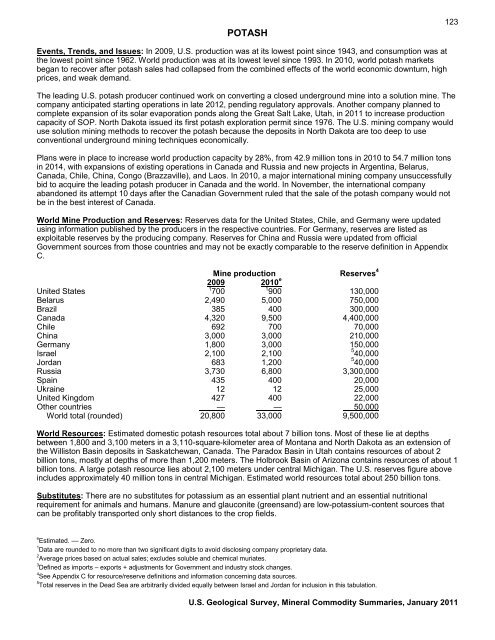POTASH123Events, Trends, <strong>and</strong> Issues: In 2009, U.S. production was at its lowest point since 1943, <strong>and</strong> consumption was atthe lowest point since 1962. World production was at its lowest level since 1993. In 2010, world potash marketsbegan to recover after potash sales had collapsed from the combined effects of the world economic downturn, highprices, <strong>and</strong> weak dem<strong>and</strong>.The leading U.S. potash producer continued work on converting a closed underground mine into a solution mine. Thecompany anticipated starting operations in late 2012, pending regulatory approvals. Another company planned tocomplete expansion of its solar evaporation ponds along the Great Salt Lake, Utah, in <strong>2011</strong> to increase productioncapacity of SOP. North Dakota issued its first potash exploration permit since 1976. The U.S. mining company woulduse solution mining methods to recover the potash because the deposits in North Dakota are too deep to useconventional underground mining techniques economically.Plans were in place to increase world production capacity by 28%, from 42.9 million tons in 2010 to 54.7 million tonsin 2014, with expansions of existing operations in Canada <strong>and</strong> Russia <strong>and</strong> new projects in Argentina, Belarus,Canada, Chile, China, Congo (Brazzaville), <strong>and</strong> Laos. In 2010, a major international mining company unsuccessfullybid to acquire the leading potash producer in Canada <strong>and</strong> the world. In November, the international companyab<strong>and</strong>oned its attempt 10 days after the Canadian Government ruled that the sale of the potash company would notbe in the best interest of Canada.World Mine Production <strong>and</strong> Reserves: Reserves data for the United States, Chile, <strong>and</strong> Germany were updatedusing information published by the producers in the respective countries. For Germany, reserves are listed asexploitable reserves by the producing company. Reserves for China <strong>and</strong> Russia were updated from officialGovernment sources from those countries <strong>and</strong> may not be exactly comparable to the reserve definition in AppendixC.Mine production Reserves 42009 2010 eUnited States 1 700 1 900 130,000Belarus 2,490 5,000 750,000Brazil 385 400 300,000Canada 4,320 9,500 4,400,000Chile 692 700 70,000China 3,000 3,000 210,000Germany 1,800 3,000 150,000Israel 2,100 2,10040,000Jordan 683 1,20040,000Russia 3,730 6,800 3,300,000Spain 435 400 20,000Ukraine 12 12 25,000United Kingdom 427 400 22,000Other countries — —50,000World total (rounded) 20,800 33,000 9,500,000World Resources: Estimated domestic potash resources total about 7 billion tons. Most of these lie at depthsbetween 1,800 <strong>and</strong> 3,100 meters in a 3,110-square-kilometer area of Montana <strong>and</strong> North Dakota as an extension ofthe Williston Basin deposits in Saskatchewan, Canada. The Paradox Basin in Utah contains resources of about 2billion tons, mostly at depths of more than 1,200 meters. The Holbrook Basin of Arizona contains resources of about 1billion tons. A large potash resource lies about 2,100 meters under central Michigan. The U.S. reserves figure aboveincludes approximately 40 million tons in central Michigan. Estimated world resources total about 250 billion tons.Substitutes: There are no substitutes for potassium as an essential plant nutrient <strong>and</strong> an essential nutritionalrequirement for animals <strong>and</strong> humans. Manure <strong>and</strong> glauconite (greens<strong>and</strong>) are low-potassium-content sources thatcan be profitably transported only short distances to the crop fields.e Estimated. –– Zero.1 Data are rounded to no more than two significant digits to avoid disclosing company proprietary data.2 Average prices based on actual sales; excludes soluble <strong>and</strong> chemical muriates.3 Defined as imports – exports + adjustments for Government <strong>and</strong> industry stock changes.4 See Appendix C for resource/reserve definitions <strong>and</strong> information concerning data sources.5 Total reserves in the Dead Sea are arbitrarily divided equally between Israel <strong>and</strong> Jordan for inclusion in this tabulation.U.S. Geological Survey, <strong>Mineral</strong> <strong>Commodity</strong> <strong>Summaries</strong>, January <strong>2011</strong>
124PUMICE AND PUMICITE(Data in thous<strong>and</strong> metric tons unless otherwise noted)Domestic Production <strong>and</strong> Use: The estimated value of pumice <strong>and</strong> pumicite sold or used in 2010 was about $12million. Domestic output came from 17 producers in 7 States. Pumice <strong>and</strong> pumicite were mined California, Oregon,New Mexico, Idaho, Nevada, Arizona, <strong>and</strong> Kansas, in descending order of production. Approximately 51% of allproduction came from California <strong>and</strong> Oregon. About 58% of mined pumice was used in the production of constructionbuilding block. Horticulture consumed nearly 25%; concrete admixture <strong>and</strong> aggregate, 7%; abrasives, 2%; <strong>and</strong> theremaining 8% was used for absorbent, filtration, laundry stone washing, <strong>and</strong> other applications.Salient Statistics—United States: 2006 2007 2008 2009 2010 eProduction, mine1 1,540 1,270 791 410 400Imports for consumption 109 37 65 26 41Exports e 18 9 15 11 13Consumption, apparent 1,630 1,290 841 425 430Price, average value, dollars per ton, f.o.b.mine or mill 28.85 22.85 20.13 29.97 30.00Employment, mine <strong>and</strong> mill, number 355 300 220 150 145Net import reliance 2 as a percentage ofapparent consumption 6 2 6 4 7Recycling: Not available.Import Sources (2006–09): Greece, 72%; Turkey, 20%; Icel<strong>and</strong>, 3%; Mexico, 2%; <strong>and</strong> other, 3%.Tariff: Item Number Normal Trade Relations12-31-10Pumice, crude or in irregularpieces, including crushed 2513.10.0010 Free.Pumice, except crude or crushed 2513.10.0080 Free.Depletion Allowance: 5% (Domestic <strong>and</strong> foreign).Government Stockpile: None.Prepared by Robert D. Crangle, Jr. [(703) 648-6410, rcrangle@usgs.gov, fax: (703) 648-7757]
- Page 3:
U.S. Department of the InteriorKEN
- Page 6 and 7:
INTRODUCTION3Each chapter of the 20
- Page 8 and 9:
5NET EXPORTS OF MINERALRAW MATERIAL
- Page 10 and 11:
SIGNIFICANT EVENTS, TRENDS, AND ISS
- Page 12 and 13:
mineral materials valued at $1.30 b
- Page 14 and 15:
11MAJOR METAL-PRODUCING AREASAuB2P1
- Page 16 and 17:
13MAJOR INDUSTRIAL MINERAL-PRODUCIN
- Page 18 and 19:
ABRASIVES (MANUFACTURED)15Events, T
- Page 20 and 21:
ALUMINUM17The United States continu
- Page 22 and 23:
ANTIMONY19Events, Trends, and Issue
- Page 24 and 25:
ARSENIC21According to university me
- Page 26 and 27:
ASBESTOS23Events, Trends, and Issue
- Page 28 and 29:
BARITE25Nationally, the rig count o
- Page 30 and 31:
BAUXITE AND ALUMINA27Events, Trends
- Page 32 and 33:
BERYLLIUM29Events, Trends, and Issu
- Page 34 and 35:
BISMUTH31Events, Trends, and Issues
- Page 36 and 37:
BORON33Events, Trends, and Issues:
- Page 38 and 39:
BROMINE35Events, Trends, and Issues
- Page 40 and 41:
CADMIUM37NiCd battery use in consum
- Page 42 and 43:
CEMENT39The manufacture of clinker
- Page 44 and 45:
CESIUM41Events, Trends, and Issues:
- Page 46 and 47:
CHROMIUM43Stockpile Status—9-30-1
- Page 48 and 49:
CLAYS45Tariff: Item Number Normal T
- Page 50 and 51:
COBALT47Events, Trends, and Issues:
- Page 52 and 53:
COPPER49Events, Trends, and Issues:
- Page 54 and 55:
DIAMOND (INDUSTRIAL)51Events, Trend
- Page 56 and 57:
DIATOMITE53Events, Trends, and Issu
- Page 58 and 59:
FELDSPAR55Feldspar use in tile and
- Page 60 and 61:
FLUORSPAR57with planned output of 1
- Page 62 and 63:
GALLIUM59In response to the unprece
- Page 64 and 65:
GARNET (INDUSTRIAL)61Events, Trends
- Page 66 and 67:
GEMSTONES63Events, Trends, and Issu
- Page 68 and 69:
GERMANIUM65Events, Trends, and Issu
- Page 70 and 71:
GOLD67With the increase in price of
- Page 72 and 73:
GRAPHITE (NATURAL)69Events, Trends,
- Page 74 and 75:
GYPSUM71Through 2010, more than 3,6
- Page 76 and 77: HELIUM73Events, Trends, and Issues:
- Page 78 and 79: INDIUM75China’s 21 indium produce
- Page 80 and 81: IODINE77Events, Trends, and Issues:
- Page 82 and 83: IRON AND STEEL79Events, Trends, and
- Page 84 and 85: IRON AND STEEL SCRAP81Tariff: Item
- Page 86 and 87: IRON AND STEEL SLAG83Events, Trends
- Page 88 and 89: IRON ORE85In 2009, China imported a
- Page 90 and 91: IRON OXIDE PIGMENTS87Events, Trends
- Page 92 and 93: KYANITE AND RELATED MATERIALS89Even
- Page 94 and 95: LEAD91caused by underground fires a
- Page 96 and 97: LIME93The lime industry is facing p
- Page 98 and 99: LITHIUM95market, and a facility at
- Page 100 and 101: MAGNESIUM COMPOUNDS97In Australia,
- Page 102 and 103: MAGNESIUM METAL99U.S. magnesium con
- Page 104 and 105: MANGANESE101Government Stockpile:St
- Page 106 and 107: MERCURY103Events, Trends, and Issue
- Page 108 and 109: MICA (NATURAL)105Depletion Allowanc
- Page 110 and 111: MOLYBDENUM107Events, Trends, and Is
- Page 112 and 113: NICKEL109Nickel prices were adverse
- Page 114 and 115: NIOBIUM (COLUMBIUM)111Events, Trend
- Page 116 and 117: NITROGEN (FIXED)—AMMONIA113Accord
- Page 118 and 119: PEAT115Events, Trends, and Issues:
- Page 120 and 121: PERLITE117Events, Trends, and Issue
- Page 122 and 123: PHOSPHATE ROCK119Events, Trends, an
- Page 124 and 125: PLATINUM-GROUP METALS121Events, Tre
- Page 128 and 129: PUMICE AND PUMICITE125Events, Trend
- Page 130 and 131: QUARTZ CRYSTAL (INDUSTRIAL)127Event
- Page 132 and 133: RARE EARTHS129Events, Trends, and I
- Page 134 and 135: RHENIUM131Events, Trends, and Issue
- Page 136 and 137: RUBIDIUM133Events, Trends, and Issu
- Page 138 and 139: SALT135Many chefs have advocated us
- Page 140 and 141: SAND AND GRAVEL (CONSTRUCTION)137Ev
- Page 142 and 143: SAND AND GRAVEL (INDUSTRIAL)139The
- Page 144 and 145: SCANDIUM141Scandium’s use in meta
- Page 146 and 147: SELENIUM143Events, Trends, and Issu
- Page 148 and 149: SILICON145Events, Trends, and Issue
- Page 150 and 151: SILVER147Silver was used as a repla
- Page 152 and 153: SODA ASH149A Wyoming soda ash produ
- Page 154 and 155: SODIUM SULFATE151Events, Trends, an
- Page 156 and 157: STONE (CRUSHED)153Events, Trends, a
- Page 158 and 159: STONE (DIMENSION)155Events, Trends,
- Page 160 and 161: STRONTIUM157Events, Trends, and Iss
- Page 162 and 163: SULFUR159World sulfur production in
- Page 164 and 165: TALC AND PYROPHYLLITE161Events, Tre
- Page 166 and 167: TANTALUM163Events, Trends, and Issu
- Page 168 and 169: TELLURIUM165Events, Trends, and Iss
- Page 170: THALLIUM167Beginning in 2009, there
- Page 173 and 174: 170TIN(Data in metric tons of tin c
- Page 175 and 176: 172TITANIUM AND TITANIUM DIOXIDE 1(
- Page 177 and 178:
174TITANIUM MINERAL CONCENTRATES 1(
- Page 179 and 180:
176TUNGSTEN(Data in metric tons of
- Page 181 and 182:
178VANADIUM(Data in metric tons of
- Page 183 and 184:
180VERMICULITE(Data in thousand met
- Page 185 and 186:
182WOLLASTONITE(Data in metric tons
- Page 187 and 188:
184YTTRIUM 1(Data in metric tons of
- Page 189 and 190:
186ZEOLITES (NATURAL)(Data in metri
- Page 191 and 192:
188ZINC(Data in thousand metric ton
- Page 193 and 194:
190ZIRCONIUM AND HAFNIUM(Data in me
- Page 195 and 196:
192APPENDIX AAbbreviations and Unit
- Page 197 and 198:
194Demonstrated.—A term for the s
- Page 199 and 200:
196Part B—Sources of Reserves Dat
- Page 201:
198Europe and Central Eurasia—con







